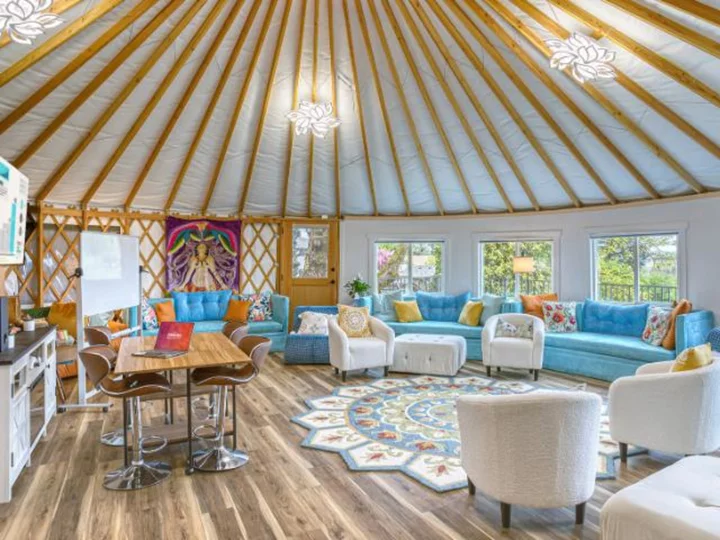At the start of the Covid-19 pandemic, nobody wanted to work full time in the office. Three years later, many of those same people have soured on working full time at home.
Enter the co-working space, which allows for a bit of everything. But it's not the glass-walled, craft beer-serving WeWork spaces you may remember from pre-pandemic times.
From shopping malls to private mansions to hotels and gyms, co-working spaces are becoming more creative in the remote work era — with a boost from startups building platforms to connect companies with spaces for rent.
The shift is being driven by the rise in hybrid work, shifts in where people live and employers seeking to lower their office costs. These changes are remaking the economy and real estate, boosting the fortunes of some urban areas in the Sun Belt while hurting other business districts in San Francisco, Chicago and New York.
"We're in the world of hybrid. The team does not need meet to meet in the downtown office anymore," said Prithwiraj Choudhury, an associate professor at Harvard Business School who studies work patterns and geography. "Co-working spaces are coming in all flavors."
Meeting in person
The pandemic permanently increased work from home, equivalent to almost 40 years of growth at the pre-pandemic pace, according to research from Nicholas Bloom, an economist at Stanford University.
The overall average number of paid days worked from home in June was 1.4 per week — 28% of the work week — according to the monthly Survey of Working Arrangements and Attitudes, which Bloom and other researchers have conducted since May 2020.
But while more people are working from home, the majority of employees do not want to stay home every day, particularly younger workers.
Among workers ages 20-29, 76% say they do not want full-time remote work, while 71% of workers ages 30-39 say they do not want full-time remote work, according to the survey.
Younger workers say full-time remote work can be isolating. Many workers still want to see colleagues and managers in person and have found that some parts of their jobs, such as mentoring, can't be performed as well via video calls.
Even for small startups and fully remote teams, the norm is to meet regularly, typically every one or two months, Bloom said.
Around 70% of fully remote employees meet their co-workers at least once a year, and 45% at least once a month, the survey shows.
That means these companies and workers need a place to meet. And it's not necessarily an office.
Companies warm to co-working
Eager to shed full-time office space they aren't using in favor of more flexible leases to save costs, bosses are giving employees the option to rent co-working spaces by the hour, by the day or on a recurring basis.
It's particularly appealing to startups and smaller companies that don't want to commit to long-term leases, experts say.
"The lease has become the enemy right now for some of these companies," said Jacob Bates, head of flexible office and co-working business at commercial real estate company JLL. According to a JLL report from May, 40% of the companies it surveyed plan to increase their use of flexible spaces, including co-working sites.
Offering workers flexible space options can also help with worker recruitment and hiring in new markets.
"The new phenomenon is the rapid growth in companies sanctioning our platforms for use by employees," said Mark Gilbreath, the CEO of Liquidspace, a marketplace for on-demand workspaces. "They're doing that hand in glove alongside rightsizing their traditional office portfolio."
The US General Services Administration uses Liquidspace, as do Spotify, Calm, AT&T, T-Mobile and other major companies, said Gilbreath.
Airstreams and yurts
The dominant co-working venues for years were WeWork and other communal spaces in downtown office buildings.
But despite the surge in interest in shared workspaces, WeWork has struggled, in part due to its high debt load and exposure to commercial real estate in cities.
Now, offbeat work sites are popping up in response to shifts in where people live and work.
The pandemic changed where people live, pushing more people to outer areas of cities and the suburbs. And that has mostly meant people are less eager to commute to their old downtown offices or business districts to collaborate.
Gilbreath from Liquidspace said that co-working spaces have expanded outside urban cores and financial districts, and rental spaces are becoming quirkier.
For example, a candy factor in Denver, a bank in Montreal and the former trading floor of the Minneapolis Grain Exchange are all listed on Liquidspace for rent.
Radious is another company taking advantage of the shift.
"Co-working spaces have usually been centrally located in big buildings," said Amina Moreau, founder of Radious, which calls its business the Airbnb of office rentals and meeting spaces in residential areas. "We want you to be able to walk to your neighbors."
She said some of Radious' most commonly-booked listings are a 1970s Airstream-turned-office with outdoor space for team gatherings, a yurt equipped for meetings and presentations on a hobby farm with alpacas, and a 100-year-old home with private offices and corn hole in the backyard. (The yurt, on a five-acre hobby farm in Portland, Oregon, costs $350 a day.)
"We have a lot of properties," Moreau said. "New construction, new homes -- they're eclectic, modern, experiential."

